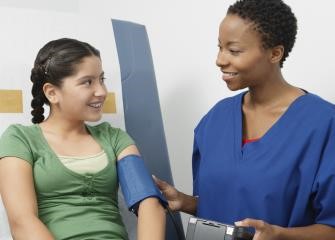An official website of the United States government
 United States Department of Labor
United States Department of Labor

Care for ill, injured, or convalescing patients or persons with disabilities in hospitals, nursing homes, clinics, private homes, group homes, and similar institutions. May work under the supervision of a registered nurse. Licensing required.
The qualifications that workers need to use judgment, make decisions, interact with others, and adapt to changes in jobs.
In 2024, more than basic people skills were required for 96.8 percent of licensed practical and licensed vocational nurses, and basic people skills were required for 3.2 percent.
| Requirement | Yes | No |
|---|---|---|
|
Adaptability: Work schedule variability |
56.0 | 44.0 |
|
Pace: Pause control |
8.4 | 91.6 |
|
Working around crowds |
<0.5 | >99.5 |
|
Telework |
<0.5 | >99.5 |
|
Work review: Supervising others |
11.5 | 88.5 |
|
Source: U.S. Bureau of Labor Statistics, Occupational Requirements Survey |
||
The minimum level of formal education required, credentials necessary, on-the-job training, and prior work experience necessary for average performance in jobs.
In 2024, prior work experience was required for 16.5 percent of licensed practical and licensed vocational nurses and on-the-job training was required for 97.2 percent.
The various tangible or concrete hazards or difficulties that are in the vicinity of where jobs’ critical tasks are performed.
In 2024, greater than 99.5 percent of licensed practical and licensed vocational nurses were not exposed to extreme cold, and greater than 99.5 percent were not exposed to extreme heat. Wetness was not present for less than 5 percent, greater than 99.5 percent were not exposed to heavy vibrations, and 76.6 percent were not exposed to the outdoors.
Refer to the physical activities required to perform tasks in jobs. The presence and, in some cases, duration of these activities are published.
In 2024, reaching at or below the shoulder was required for greater than 95 percent of licensed practical and licensed vocational nurses and was not required for less than 5 percent. For 5.4 percent of workers, reaching at or below the shoulder was seldom performed, for 75.9 percent reaching at or below the shoulder occurred occasionally, 17.1 percent frequently, and for less than 0.5 percent reaching at or below the shoulder occurred constantly.
Performing work in low postures was required for 87.0 percent of licensed practical and licensed vocational nurses and was not required for 13.0 percent.
On average, licensed practical and licensed vocational nurses spent 39.3 percent of the workday sitting and 60.7 percent of the workday standing.
| Requirement | Yes | No |
|---|---|---|
|
Choice of sitting or standing |
<10 | >90 |
|
Driving |
25.3 | 74.7 |
|
Climbing structure-related ramps or stairs |
29.9 | 70.1 |
|
Source: U.S. Bureau of Labor Statistics, Occupational Requirements Survey |
||